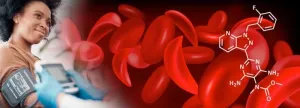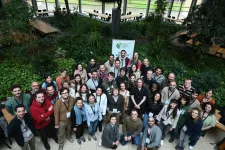(Press-News.org) DURHAM, N.C. -- Left unchecked, corrosion can rust out cars and pipes, take down buildings and bridges, and eat away at our monuments.
Corrosion can also damage devices that could be key to a clean energy future. And now, Duke University researchers have captured extreme close-ups of that process in action.
“By studying how and why renewable energy devices break down over time, we might be able to extend their lifetime,” said chemistry professor and senior author Ivan Moreno-Hernandez.
In his lab at Duke sits a miniature version of one such device. Called an electrolyzer, it separates hydrogen out of water, using electricity to power the reaction.
When the electricity to power electrolysis comes from renewable sources such as wind or solar, the hydrogen gas it churns out is considered a promising source of clean fuel, because it takes no fossil fuels to produce and it burns without creating any planet-warming carbon dioxide.
A number of countries have plans to scale up their production of so-called “green hydrogen” to help curb their dependence on fossil fuels, particularly in industries like steel- and cement-making.
But before hydrogen can go mainstream, some big obstacles need to be overcome.
Part of the trouble is electrolyzers require rare metal catalysts to function, and these are prone to corrosion. They’re not the same after a year of operation than they were in the beginning.
In a study published April 10 in the Journal of the American Chemical Society, Moreno-Hernandez and his Ph.D. student Avery Vigil used a technique called liquid phase transmission electron microscopy to study the complex chemical reactions that go on between these catalysts and their environment that cause them to decay.
You might remember from high school that to make hydrogen gas, an electrolyzer splits water into its constituent hydrogen and oxygen molecules. For the current study, the team focused on a catalyst called ruthenium dioxide that speeds up the oxygen half of the reaction, since that’s the bottleneck in the process.
“We essentially put these materials through a stress test,” Vigil said.
They zapped nanocrystals of ruthenium dioxide with high-energy radiation, and then watched the changes wrought by the acidic environment inside the cell.
To take pictures of such tiny objects, they used a transmission electron microscope, which shoots a beam of electrons through nanocrystals suspended inside a super-thin pocket of liquid to create time-lapse images of the chemistry taking place at 10 frames per second.
The result: desktop-worthy close-ups of virus-sized crystals, more than a thousand times finer than a human hair, as they get oxidized and dissolve into the acidic liquid around them.
“We're actually able to see the process of this catalyst breaking down with nanoscale resolution,” Moreno-Hernandez said.
Over the course of five minutes, the crystals broke down fast enough to “render a real device useless in a matter of hours,” Vigil said.
Zooming in hundreds of thousands of times, the videos reveal subtle defects in the crystals’ 3D shapes that create areas of strain, causing some to break down faster than others.
By minimizing such imperfections, the researchers say it could one day be possible to design renewable energy devices that last two to three times longer than they currently do.
“So instead of being stable for, say, two years, an electrolyzer could last six years. That could have a massive impact on renewable technologies,” Moreno-Hernandez said.
This research was supported by grants from the National Science Foundation (DGE-2139754, ECCS-2025064, ECCS-2025064).
CITATION: "Dissolution Heterogeneity Observed in Anisotropic Ruthenium Dioxide Nanocrystals via Liquid-Phase Transmission Electron Microscopy," S. Avery Vigil, Ivan A. Moreno-Hernandez. Journal of the American Chemical Society, April 10, 2024. https://doi.org/10.1021/jacs.3c13709
END
Nanoscale movies shed light on one barrier to a clean energy future
Research could dramatically extend the lifetime of the devices needed to turn hydrogen green
2024-04-11
ELSE PRESS RELEASES FROM THIS DATE:
American College of Lifestyle Medicine announces first two medical schools to earn highest recognition and certification for lifestyle medicine curriculum
2024-04-11
The American College of Lifestyle Medicine (ACLM) has announced that the University of South Carolina School of Medicine Greenville (SOMG) and Loma Linda University School of Medicine (LLUSM) are the first to earn the highest recognition of a “Platinum Plus” certification designation for the significant level of undergraduate lifestyle medicine curricula within their programs.
The Platinum Plus is the highest tier of certification that a medical school can receive from ACLM and indicates the incorporation of at least 100 hours of evidence-based lifestyle medicine content within the curriculum. This level of lifestyle medicine ...
Avi Wigderson receives ACM A.M. Turing Award for groundbreaking insights on randomness
2024-04-11
ACM, the Association for Computing Machinery, today named Avi Wigderson as recipient of the 2023 ACM A.M. Turing Award for foundational contributions to the theory of computation, including reshaping our understanding of the role of randomness in computation, and for his decades of intellectual leadership in theoretical computer science.
Wigderson is the Herbert H. Maass Professor in the School of Mathematics at the Institute for Advanced Study in Princeton, New Jersey. He has been a leading figure in areas including computational complexity theory, algorithms and optimization, randomness and cryptography, parallel and distributed computation, combinatorics, and graph theory, as well as ...
NAWI awarded funding to continue to accelerate research and development for a secure water future
2024-04-11
– By Lauren Core
The National Alliance for Water Innovation (NAWI), which is led by the Department of Energy’s (DOE) Lawrence Berkeley National Laboratory (Berkeley Lab), has been extended for five more years with $75 million in funding from DOE. NAWI will continue its contributions to helping decarbonize the water and wastewater sectors through investments in technologies that enhance the efficient use of energy for water use, treatment, and distribution.
“Water and energy are interdependent – water is used to produce nearly every major energy source, and ...
2024 Research Fellowship Awards to support three exciting disease intervention research projects
2024-04-11
Systems Biology Ireland (SBI) at University College Dublin (UCD) and The Quantitative Biosciences Institute (QBI) at the University of California, San Francisco (UCSF), and) have announced the 2024 winners of the joint Research Fellowship Awards (RFAs).
The Research Fellowship Awards aim to support collaborative high quality and ground -breaking research proposals from QBI-UCSF and UCD in the areas of network biology and drug/drug target discovery.
The winning projects for 2024 are:
“Overcoming Resistance to HER2-Targeted Therapies in Breast Cancer,” ...
Laura Soucek receives an ERC Advanced Grant to maximize the clinical and preclinical use of the first viable MYC inhibitor
2024-04-11
Laura Soucek, an ICREA Research Professor, Director of VHIO’s Experimental Therapeutics Program, and Head of our Models of Cancer Therapies Group, has received a European Research Council (ERC) Advanced Grant to maximize the use of the first clinically viable MYC inhibitor.
This ERC funding program is amongst the EU’s most prestigious and competitive, providing leading senior researchers with the opportunity to pursue ambitious, curiosity-driven projects that could lead to major scientific breakthroughs. The new grants, worth in total nearly €652 million, are part of the EU’s Horizon Europe programme. ...
UMSOM researchers identify safety of a potential new treatment to manage complications from sickle cell disease
2024-04-11
A drug approved to treat pulmonary arterial hypertension may be effective at managing hypertension and end-organ damage in patients with sickle cell disease, according to a new study published in Lancet Haematology. An early phase randomized clinical trial involving 130 patients with sickle cell disease found that the drug, called riociguat, was found to be safe to use and well tolerated in these patients and significantly improved their blood pressure. Preliminary efficacy data suggested the medication might improve heart function.
An estimated 100,000 Americans ...
Advancing biodiversity data analysis at B-Cubed’s Hackathon
2024-04-11
B-Cubed’s Hackathon – “Hacking Biodiversity Data Cubes for Policy” – concluded successfully on 5 April in Brussels. The event marked a significant milestone in the use of data cubes for enhancing biodiversity data analysis and policy-making. Over four days, participants from diverse backgrounds collaborated to explore innovative solutions aimed at standardising and improving the accessibility of biodiversity data.
The event began with a foundational presentation on data cubes by Andrew Rodrigues ...
Hypertensive disorders of pregnancy increase risk of cardiovascular death after giving birth
2024-04-11
Rutgers Health researchers have found that hypertensive disorders in pregnancy are strongly associated with fatal cardiovascular disease for up to a year after birth.
Among the hypertensive disorders that cause dangerously high blood pressure during pregnancy — chronic hypertension, gestational hypertension, preeclampsia without severe features, preeclampsia with severe features, superimposed preeclampsia and eclampsia — all but gestational diabetes were associated with a doubling in the risk of fatal cardiovascular disease compared to women with normal blood pressure.
Eclampsia, a condition whereby hypertensive ...
Blood stem cells unlock clues for helping sepsis patients fight recurring infections
2024-04-11
Severe sepsis from bacterial or viral infections can be life-threatening and even people recovering from severe sepsis may experience long-lasting effects on the immune system, making them more susceptible to recurrent infections. The causes for this sepsis-induced immune suppression are not well understood and lack an effective treatment. To better understand the cause, Katherine MacNamara and colleagues from Albany Medical College, USA, analyzed the blood stem cells of mice with prior sepsis and their results were recently published in the journal Stem Cell Reports.
During ...
Climate: Increased threat to coastlines from concurrent heatwaves and sea level rises
2024-04-11
Concurrent occurrences of heatwaves and extreme short-term sea level rises at the same coastal locations significantly increased between 1998 and 2017 when compared to the preceding twenty years, reports a study published in Communications Earth & Environment. The study also suggests that these events may be five times more likely to occur between 2025 and 2049 under a modelled high emissions scenario.
A so-called ‘concurrent heatwave and extreme sea level’ (CHWESL) event is when a heatwave and an extreme short-term sea level rise occur at the same coastal location over the same time period. Although they ...
LAST 30 PRESS RELEASES:
First Editorial of 2026: Resisting AI slop
Joint ground- and space-based observations reveal Saturn-mass rogue planet
Inheritable genetic variant offers protection against blood cancer risk and progression
Pigs settled Pacific islands alongside early human voyagers
A Coral reef’s daily pulse reshapes microbes in surrounding waters
EAST Tokamak experiments exceed plasma density limit, offering new approach to fusion ignition
Groundbreaking discovery reveals Africa’s oldest cremation pyre and complex ritual practices
First breathing ‘lung-on-chip’ developed using genetically identical cells
How people moved pigs across the Pacific
Interaction of climate change and human activity and its impact on plant diversity in Qinghai-Tibet plateau
From addressing uncertainty to national strategy: an interpretation of Professor Lim Siong Guan’s views
Clinical trials on AI language model use in digestive healthcare
Scientists improve robotic visual–inertial trajectory localization accuracy using cross-modal interaction and selection techniques
Correlation between cancer cachexia and immune-related adverse events in HCC
Human adipose tissue: a new source for functional organoids
Metro lines double as freight highways during off-peak hours, Beijing study shows
Biomedical functions and applications of nanomaterials in tumor diagnosis and treatment: perspectives from ophthalmic oncology
3D imaging unveils how passivation improves perovskite solar cell performance
Enriching framework Al sites in 8-membered rings of Cu-SSZ-39 zeolite to enhance low-temperature ammonia selective catalytic reduction performance
AI-powered RNA drug development: a new frontier in therapeutics
Decoupling the HOR enhancement on PtRu: Dynamically matching interfacial water to reaction coordinates
Sulfur isn’t poisonous when it synergistically acts with phosphine in olefins hydroformylation
URI researchers uncover molecular mechanisms behind speciation in corals
Chitin based carbon aerogel offers a cleaner way to store thermal energy
Tracing hidden sources of nitrate pollution in rapidly changing rural urban landscapes
Viruses on plastic pollution may quietly accelerate the spread of antibiotic resistance
Three UH Rainbow Babies & Children’s faculty elected to prestigious American Pediatric Society
Tunnel resilience models unveiled to aid post-earthquake recovery
Satellite communication systems: the future of 5G/6G connectivity
Space computing power networks: a new frontier for satellite technologies
[Press-News.org] Nanoscale movies shed light on one barrier to a clean energy futureResearch could dramatically extend the lifetime of the devices needed to turn hydrogen green




